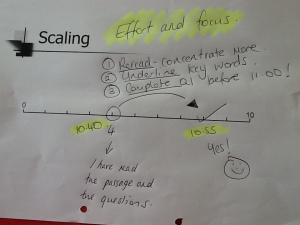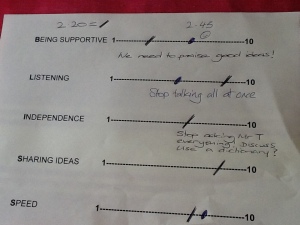Unlike any other year in my career, I have taught all mixed ability classes in 2015/2016. With previous timetables either dominated completely or almost completely of set groups based on prior attainment, it was a cause of anxiety. Could I manage to meet the needs of a much wider ability change? Would my approach to differentiation forged in sets be enough and if not, how much extra work would it take? The following are strategies that have helped considerably and rate favourably on the time versus impact axis.
1. Modelling learning.
I consider myself a growth mindset teacher, so modelling such things as mistake making, being unsure, using a dictionary, memorising have always been there, but mixed ability teaching demands they are part of every lesson for every learner in the classroom.
2. Same style starter.
We have the same style starter every lesson for a half term. It will have different challenges and different entry points, but the instructions are the same and by the end of the third lesson and students start to do it without instruction. I am not sure if it is the routine, the absence of my voice or the space to settle, but it has had an extremely positive impact on at least one class.
3. TA is everyone’s friend
We are just starting to trial this, but it involves the teaching assistant having learning conversations with all members of the class to avoid being associated with one particular group or students. Likewise for me.
4. Everyone is a TA and everyone is a teacher
All students get short opportunities to observe group work as roving reporter. Students are invited to summarise instructions or give reminders about success criteria. Students can be asked to write up notes on the board and or work with another group.
5. No hands up and no pattern
Desperate to avoid the pattern of lower order questions at the start aimed at weaker students and then higher order with more able, I have had to work hard on this without completely randomising it. This has been my mantra: no discernible patterns in questioning for students; no being able to predict when their question might come up; and no being able to sit back when they think they have been done with.
6. Sophisticated vocabulary-again and again
Short and frequent bursts of whole class taboo (student in front of the board responding to clues about the key word on the board behind them). This also serves a ‘light breather’ in 100 minute lesson, but means that every student will present some range of sophisticated vocabulary in their writing.
7. Explicit outcomes and big arrows
This involves very clear repetition of expectations to the class about what exactly they will produce with no ceiling. ‘Everyone will write at least one paragraph’ about this extract. I have been worried that some students will attempt only the minimum outcome and this is sometimes the case and prompting and monitoring are required. However, there are many students who have unlocked ambition and consciously go beyond the minimum as they are not hemmed into an ‘orange’ task. I use a big arrow on the board to emphasise that the outcome can take place on a spectrum.
8. Support resources
Support resources are essential, but not for everyone as some learners, in my experience in the past, will use these when entirely unneeded. I will hand them out separately based on apparent need. I have also placed them in exercise books before the lesson.
9. Challenge and support habits
This is embedded in my classroom talk and my feedback. For example, analysing sentence structure for certain students who have mastered language analysis or for others, ‘magpieing’ sentence starters from texts for their own writing. It has taken a while, but students are independently displaying these learning behaviours.
10. Explicit reading strategies
Inspired by various forms of CPD on reading, we regularly reflect prior to meeting a new text on the reading strategies we use (see previous posts). There are opportunities to draw what we read, label paragraphs and predict. When we encounter vocabulary, students are building the habit of looking inside the word and then around it before reaching for dictionary. I will discuss what previous experiences and reading, I am using to support my understanding of unseen texts.


 <
<